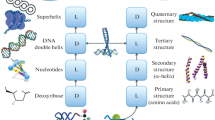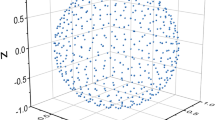Abstract
A method was designed to describe the helical structures of various levels of organization in proteins. The method makes it possible to characterize the sign of chirality/helicity and to quantify α-helices, 310-helices, and coiled-coil structures. The data is important for developing the earlier concept of sign-alternating chiral hierarchies of nucleic acid and protein structures. A sufficient condition for the method is the relative location of α-carbons in the helix. With this condition satisfied, the amount of information to be processed can be reduced by one order of magnitude. The method thus offers a clear benefit for processing large data sets.




Similar content being viewed by others
REFERENCES
A. V. Finkelstein and O. B. Ptitsyn, Protein Physics: A Course of Lectures (KDU, Moscow, 2012; Academic Press, 2016).
L. Pauling and R. B. Corey, Proc. Natl. Acad. Sci. U. S. A. 37, 256 (1951).
L. Pauling and R. B. Corey, Proc. Natl. Acad. Sci. U. S. A. 37, 729 (1951).
D. J. Barlow and J. M. Thornton, J. Mol. Biol. 201, 601 (1988).
M. N. Fodje and S. Al-Karadaghi, Protein Eng. 15, 353 (2002).
J. S. Richardson and D. C. Richardson, Science 240, 1648 (1988).
L. Pauling, R. B. Corey, and H. R. Branson, Proc. Natl. Acad. Sci. U. S. A. 37, 205 (1951).
F. H. C. Crick, Nature 170, 882 (1952).
F. H. C. Crick, Acta Crystallogr. 6, 685 (1953a).
F. H. C. Crick, Acta Crystallogr. 6, 689 (1953b).
A. Rose, S. J. Schraegle, E. A. Stahlberg, and I. Meier, BMC Evol Biol. 5, 66 (2005).
O. J. Rackham, M. Madera, C. T. Armstrong, et al., J. Mol. Biol. 403, 480 (2010).
E. Moutevelis and D. N. Woolfson, J. Mol. Biol. 385, 726 (2009).
J. Seo and C. Cohen, Proteins 15, 223 (1993).
A. Lupas and M. Gruber, Adv. Protein Chem. 70, 37 (2005).
Y. B. Yu. Adv. Drug Delivery Rev. 54 (8), 1113 (2002).
V. A. Tverdislov, Biophysics (Moscow), 58 (1), 128 (2013).
V. A. Tverdislov and E. V. Malyshko, Usp. Fiz. Nauk 189, 375 (2019).
G. N. Ramachandran, C. Ramakrishnan, and V. Sasisekharan, J. Mol Biol. 7, 95 (1963).
A. E. Sidorova, E. V. Malyshko, A. R. Kotov, et al., Biophysics (Moscow) 64 (2), 155 (2019).
A. E. Sidorova, N. T. Levashova, E. V. Malyshko, and V. A. Tverdislov, Moscow Univ. Phys. Bull. 74 (3), 213 (2019).
RCSB PDB. http://www.rcsb.org. Accessed on December 15, 2020.
G. N. Phillips, Proteins 14, 425 (1992).
R. D. B. Fraser and T. P. MacRae, Conformation in Fibrous Proteins and Related Synthetic Polypeptides (Academic, London, 1973).
Funding
This work was supported by the Basic and Applied Space Research Interdisciplinary Research-and-Education School (Moscow State University) and the Russian Science Foundation (project no. 19-74-00082).
Author information
Authors and Affiliations
Corresponding author
Ethics declarations
Conflict of interests. The authors declare that they have no conflict of interest.
Statement on the welfare of humans or animals. This article does not contain any studies involving animals performed by any of the authors.
Additional information
Translated by T. Tkacheva
Rights and permissions
About this article
Cite this article
Sidorova, A.E., Lutsenko, A.O., Shpigun, D.K. et al. Methods to Determine the Chirality Sign for Helical and Superhelical Protein Structures. BIOPHYSICS 66, 357–363 (2021). https://doi.org/10.1134/S0006350921030180
Received:
Revised:
Accepted:
Published:
Issue Date:
DOI: https://doi.org/10.1134/S0006350921030180




